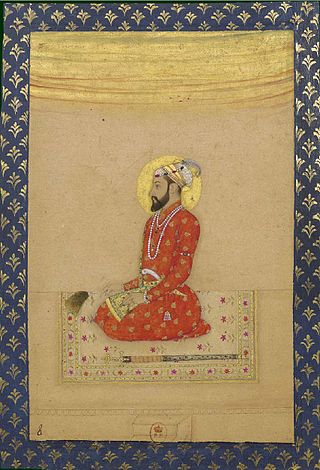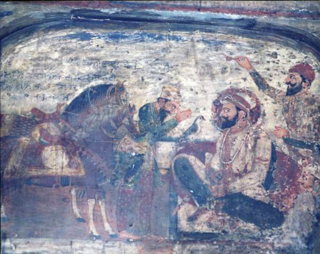
Mirza Shahab-ud-Din Muhammad Khurram, commonly called Shah Jahan I, also called Shah Jahan the Magnificent, was Emperor of Hindustan from 1628 until his deposition in 1658. As the fifth Mughal emperor, his reign marked the zenith of Mughal architectural and cultural achievements.

Mumtaz Mahal was the empress consort of Mughal Empire from 1628 to 1631 as the chief consort of the fifth Mughal emperor, Shah Jahan. The Taj Mahal in Agra, often cited as one of the Wonders of the World, was commissioned by her husband to act as her tomb.

Mirza Muhammad Mu'azzam, commonly known as Bahadur Shah I and Shah Alam I, was the eighth Mughal Emperor from 1707 to 1712. He was the second son of the sixth Mughal emperor Aurangzeb, who he conspired to overthrow in his youth. He was also governor of the imperial provinces of Agra, Kabul and Lahore and had to face revolts of Rajputs and Sikhs.

The Lahore Fort is a citadel in the walled interior of Lahore in Punjab, Pakistan. The fortress is located at the northern end of the Walled City of Lahore and spreads over an area greater than 20 hectares. It contains 21 notable monuments, some of which date to the era of Emperor Akbar. The Lahore Fort is notable for having been almost entirely rebuilt in the 17th century, when the Mughal Empire was at the height of its splendor and opulence.

The Walled City of Lahore, also known as the Old City, forms the historic core of the city of Lahore in Punjab, Pakistan. The city was established around 1000 CE in the western half of the Walled City, which was fortified by a mud wall during the medieval era. It has been the primary cultural centre of the Punjab region since the late-medieval era.

Guru Har Rai revered as the seventh Nanak, was the seventh of ten Gurus of the Sikh religion. He became the Sikh leader at age 14, on 3 March 1644, after the death of his grandfather and the sixth Sikh leader Guru Hargobind. He guided the Sikhs for about seventeen years, till his death at age 31.

Guru Hargobind was the sixth of ten Gurus of the Sikh religion. He had become Guru at the young age of eleven, after the execution of his father, Guru Arjan, by the Mughal emperor Jahangir.

Mughal architecture is the type of Indo-Islamic architecture developed by the Mughals in the 16th, 17th and 18th centuries throughout the ever-changing extent of their empire in the Indian subcontinent. It developed from the architectural styles of earlier Muslim dynasties in India and from Iranian and Central Asian architectural traditions, particularly Timurid architecture. It also further incorporated and syncretized influences from wider Indian architecture, especially during the reign of Akbar. Mughal buildings have a uniform pattern of structure and character, including large bulbous domes, slender minarets at the corners, massive halls, large vaulted gateways, and delicate ornamentation; examples of the style can be found in modern-day Afghanistan, Bangladesh, India and Pakistan.

Chiniot is a city and the administrative headquarters of Chiniot District in the province of Punjab, Pakistan. Located on the bank of the river Chenab, it is the 28th largest city of Pakistan. It is also known for its intricate wooden furniture, architecture, and mosques, and is home to the Omar Hayat Mahal.

Bidhi ChandChhina was a Sikh religious preacher and military commander, from Chhina Bidhi Chand village, 37 kilometers south of Amritsar and Chhina Bidhi Chand was part of Amritsar District not Lahore. His birth place temple is situated in his own village Chhina Bidhi Chand, which was built by the residents with the help of Baba Daya Singh. Baba Daya Singh laid foundation with his own hands. Every year on his birthday Baba Daya Singh, and now Baba Avtar Singh, would go to village Chhina Bidhi Chand and celebrate it there to date. He was a disciple of Guru Arjan and served Guru Hargobind for most of his life.

Bandi Chhor Divas, also known as Bandi Chhor Dihara, is a Sikh celebration commemorating the day when the sixth Guru of Sikhs, Guru Hargobind, and 52 Hindu kings were released from Gwalior Fort, who had been imprisoned by Mughal Emperor Jahangir. Emperor Jahangir had held 52 Kings at the Gwalior Fort for several months. Gurdwara Data Bandi Chhor Sahib is located at the place of the Guru's internment in the Fort. The day falls in autumn and often overlaps with Hindu Diwali, the festival of lights celebrated across Punjab and the rest of India. Historically, from the time of the third Sikh Guru Amar Das, Sikhs and Hindus of the time used the occasion of Diwali, Vaisakhi and other such festivals to congregate at the seat of the Gurus. In 2003, Sikh religious leaders and the Shiromani Gurdwara Parbandhak Committee led by Prof. Kirpal Singh Badungar formally adopted this day into the Nanakshahi calendar.

The Sikh Rule in Lahore initiated from the conquest and rule of the Sikh Misls and extended till the Sikh Empire of Ranjit Singh which ended in 1849. The Sikhs began gaining power following the decline of the Mughal Empire in Punjab and consisted of a collection of autonomous Punjabi Misls, which were governed by Misldars, mainly in the Punjab region.

Abu'l-Hasan entitled by the Mughal emperor Jahangir as Asaf Khan, was the Grand Vizier of the fifth Mughal emperor Shah Jahan. He previously served as the vakil of Jahangir. Asaf Khan is perhaps best known for being the father of Arjumand Banu Begum, the chief consort of Shah Jahan and the older brother of Empress Nur Jahan, and the maternal grandfather of mughal emperor Aurangzeb.
The Battle of Jajau was fought between the two Mughal princes and brothers Bahadur Shah I and Muhammad Azam Shah on 20 June 1707. In 1707, their father Aurangzeb died without having declared a successor; instead leaving a will in which he instructed his sons to divide the empire between themselves. Their failure to reach a satisfactory agreement led to a military conflict. After Azam Shah and his three sons were killed in the Battle of Jajau, Bahadur Shah I was crowned as the Mughal emperor on 19 June 1707 at the age of 63.

The Shahi Hammam, also known as the Wazir Khan Hammam, is a Turkish bath which was built in Lahore, Punjab, Pakistan, in 1635 C.E. during the reign of Emperor Shah Jahan. It was built by chief physician to the Mughal Court, Ilam-ud-din Ansari, who was widely known as Wazir Khan. The baths were built to serve as a waqf, or endowment, for the maintenance of the Wazir Khan Mosque.

The Subah of Lahore was one of the three subahs (provinces) of the Mughal Empire in the Punjab region, alongside Multan and Delhi subahs, encompassing the northern, central and eastern Punjab. It was created as one of the original 12 Subahs of the Mughal Empire under the administrative reforms carried by Akbar in 1580. The province ceased to exist after the death of its last viceroy, Adina Beg in 1758, with large parts being incorporated into Durrani Empire. Collectively, Lahore and Multan subahs, and parts of Delhi subah, comprised Mughal Punjab.

Mullah Shukrullah Shirazi (1570–1639), known by the royal title Afzal Khan, was a Mughal courtier during the reigns of Jahangir and Shah Jahan. He achieved fame as a scholar and rose to become Grand Vizier of the Mughal Empire.

Sa'adullah Khan, also spelled Sadullah Khan was the Grand Vizier and Vakil-I-Mutlaq of the Mughal Empire during the reign of Shah Jahan I.

The Akāl Sena was the Sikh military force established by the sixth Sikh Guru, Guru Hargobind. It was the first standing Sikh army. It was also known as the Akali Dal.

Dilbagh and Gulbagh, later renamed Jan Bhai and Suhela, were two horses that were associated with the sixth Sikh guru, Guru Hargobind.
























